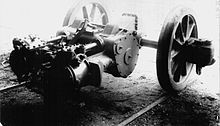MÁV series BCmot VIIa
| MÁV series BCmot VIIa | |
|---|---|
| Numbering: | MÁV BCmot 03.001-002 MÁV BCmot 06.101-102 |
| Number: | 2 |
| Manufacturer: | Ganz & Co. , Budapest |
| Year of construction (s): | 1903 |
| Retirement: | unknown |
| Type : | A1 'n2v |
| Gauge : | 1435 mm ( standard gauge ) |
| Length over buffers: | 10,950 mm |
| Total wheelbase: | 5,500 mm |
| Service mass: | 14.5 t |
| Friction mass: | 11 t |
| Top speed: | 45 km / h |
| Indexed performance : | 26 kW (35 hp) |
| Wheel diameter: | 1,008 mm |
| Control type : | Smart |
| Number of cylinders: | 4th |
| HD cylinder diameter: | 116 mm |
| LP cylinder diameter: | 170 mm |
| Piston stroke: | 140 mm |
| Boiler : | De Dion-Bouton |
| Boiler overpressure: | 18 bar |
| Grate area: | 0.3 m² |
| Superheater area : | 2.7 m² |
| Evaporation heating surface: | 5.7 m² |
| Water supply: | 1,000 l |
| Fuel supply: | 100 kg |
| Seats: | 9/24 |
| Classes : | 2nd / 3rd |
The two-axle steam railcar of MÁV series BCmot VIIa were at 1903. Ganz & Co. in Budapest produced and served as railcars for the Hungarian State Railways MÁV . They were manufactured according to the De Dion-Bouton system and had an output of 26 kW (35 hp).
history
Railway lines of the Hungarian state railway MÁV were considered to be particularly steam railcar-friendly around the 1900s , as the company owned many branch lines with little traffic and relatively low gradients. Most of the vehicles required were manufactured by Ganz in Budapest. For this purpose, the company acquired licenses from De Dion-Bouton and built steam railcars with 35, 50 and 80 hp.
According to the literature, a total of 89 steam railcars should have been delivered to MÁV between Ganz and the end of 1906; Pospichal only mentions 30 vehicles. These two steam railcars are considered to be the first in this category.
The vehicles were used in the Szentes area . In general, they had too high maintenance costs and too high consumption of resources. The maintenance of the boiler required a lot of effort, which was increased by poor water quality. At the outbreak of the First World War , they were retired.
technical features
The car body corresponded to the standard of the then valid principles of passenger car construction. The steam engine was stored in the front, drawn-in room.
The vehicle had a water tube boiler developed by De Dion-Bouton and manufactured by Ganz and a steam engine from the same manufacturer. In this system, the boiler was arranged upright and consisted of two centrically nested cylindrical ring bodies. They were connected to each other by inclined pipe sockets and were thus kept at a distance. The inner one served as a combustion chamber and filling shaft for the fuel. Coke was mainly used for this furnace. The combustion air was regulated by flaps in the ash pan. The grate was designed as a tilting grate for faster emptying and cleaning. The boiler construction was very light, with the disadvantage of a small steam and water room. One advantage of this type of boiler was the short heating-up time. 30 kg of charcoal were enough to reach a pressure of 20 bar in the boiler after one hour.
The steam engine consisted of two two-cylinder compound engines . They ran at about 600 to 800 min −1 and were stored floating in a housing in an oil bath. Similar to a pawl bearing drive , it was firmly connected to the axle and resiliently mounted in the frame. The torque was transmitted by a gear drive. The control according to the Kluge system was otherwise not used in steam locomotive construction. A starting device could convert the steam engine into a twin engine through valves. Some of the De Dion-Bouton type steam railcars had to be turned in the terminus, some of the vehicles already had driver's cabs on both sides. It is not clear from the documents how the vehicles described here were equipped.
See also
literature
- Rolf Ostendorf: Steam railcars, types and systems , Motorbuchverlag, Stuttgart, ISBN 3-87943-517-0
- Alfred Horn: Steam railcars and baggage locomotives in Hungary , Bohmann Verlag KG Vienna: 1972
Web links
Individual evidence
- ^ A b c d Alfred Horn: Steam railcars and baggage locomotives in Hungary , Bohmann Verlag KG Vienna: 1972, page 33
- ↑ List of Hungarian steam engines at www.pospichal.net
- ↑ a b c Rolf Ostendorf: Steam railcars, types and systems , Motorbuchverlag, Stuttgart, ISBN 3-87943-517-0 , page 39
